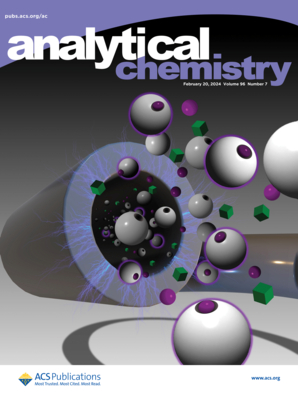Au@Pt DNA纳米机器与光子晶体微芯片耦合实现高保真和便携式miRNA检测。
IF 6.7
1区 化学
Q1 CHEMISTRY, ANALYTICAL
引用次数: 0
摘要
虽然3D DNA纳米机器(由DNA功能化的金纳米粒子(Au NPs)构建)在复杂介质中用于敏感的miRNA检测方面取得了很大进展,但它们的稳定性、可及性和可移植性仍有待改进。为了克服这些障碍,我们率先开发了一种新方法,将Au@Pt (Pt-coated Au NPs) DNA纳米机器与光子晶体(PC)微芯片集成在一起,用于精确和便携式的miRNA检测。利用超低配体交换率的Au@Pt作为3D DNA纳米机的核心,使Au@Pt DNA纳米机具有优越的稳定性和信号保真度。同时,具有荧光增强能力的PC微芯片作为固相传感器芯片,通过与小型化紫外灯设备和配备颜色识别软件的智能手机接口,实现现场和便携式miRNA-21检测。这种新开发的传感器具有对miRNA的快速响应,卓越的稳定性和对生物硫醇的强大抗性,以及高灵敏度(LOD低至0.144 pM)。临床验证表明,该方法对患者血清中miRNA-21的检测具有良好的诊断准确性(AUC = 1),为资源和设备有限地区的现场和便携式miRNA检测提供了范例。本文章由计算机程序翻译,如有差异,请以英文原文为准。
Au@Pt DNA Nanomachine Coupled with Photonic Crystal Microchip Enables High-Fidelity and Portable miRNA Detection.
Although great headway has been made in 3D DNA nanomachines, built from DNA-functionalized gold nanoparticles (Au NPs), for sensitive miRNA detection in complex media, their stability, accessibility, and portability still need to be improved. To surmount these hurdles, we are the first to develop a new way to integrate a Au@Pt (Pt-coated Au NPs) DNA nanomachine with a photonic crystal (PC) microchip for accurate and portable miRNA detection. Leveraging Au@Pt, characterized by ultraslow ligand exchange rate, as the core of 3D DNA nanomachines endows Au@Pt DNA nanomachine superior stability and signal fidelity. Meanwhile, a PC microchip capable of fluorescence enhancement capability acts as a solid-phase sensor chip, enabling on-site and portable miRNA-21 detection by interfacing with a miniaturized UV lamp device and a smartphone equipped with color recognition software. This newly developed sensor exhibits a swift response to miRNA, remarkable stability, and robust resistance to biothiols, as well as a high sensitivity (LOD as low as 0.144 pM). Clinical validation demonstrates its excellent diagnostic accuracy (AUC = 1) in the detection of miRNA-21 in patient serum, providing a paradigm for on-site and portable miRNA detection in areas with limited resources and equipment.
求助全文
通过发布文献求助,成功后即可免费获取论文全文。
去求助
来源期刊

Analytical Chemistry
化学-分析化学
CiteScore
12.10
自引率
12.20%
发文量
1949
审稿时长
1.4 months
期刊介绍:
Analytical Chemistry, a peer-reviewed research journal, focuses on disseminating new and original knowledge across all branches of analytical chemistry. Fundamental articles may explore general principles of chemical measurement science and need not directly address existing or potential analytical methodology. They can be entirely theoretical or report experimental results. Contributions may cover various phases of analytical operations, including sampling, bioanalysis, electrochemistry, mass spectrometry, microscale and nanoscale systems, environmental analysis, separations, spectroscopy, chemical reactions and selectivity, instrumentation, imaging, surface analysis, and data processing. Papers discussing known analytical methods should present a significant, original application of the method, a notable improvement, or results on an important analyte.
 求助内容:
求助内容: 应助结果提醒方式:
应助结果提醒方式:


